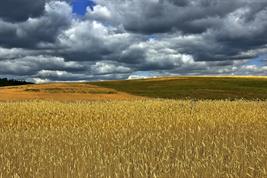14.05.2024

A study recently published in the journal Landscape Ecology by the Leibniz Centre for Agricultural Landscape Research (ZALF) investigates the diversity of crop rotations in Brandenburg's agricultural landscapes and the factors that influence this diversity. The findings are particularly relevant as they show how agricultural practices could be adapted to meet the challenges of climate change and declining biodiversity. The study was carried out in collaboration with the Leibniz Institute of Agricultural Development in Transition Economies (IAMO) and used novel methods of data analysis.
The ZALF study shows that a higher crop rotation diversity, i.e. more crop species, is often found in intensively farmed landscapes with good soil quality and few natural structural elements. Josepha Schiller, first author of the study, explains: "Our research shows that there is a spatial trade-off between crop diversity and the landscape, i.e. competition for space." The recommendation? In regions with high crop diversity and low landscape diversity, the focus should be on improving landscape structure. On the other hand, in highly structured landscapes, priority should be given to crop diversity.
Increasing the diversity of crops in a rotation can improve soil health, reduce the risk of pests and disease and safeguard yields. This is important to meet the challenges of climate change. Farmers can therefore gain economic benefits from appropriate crop rotation.
The ZALF study provides important insights into how to design a more sustainable agricultural landscape. It is essential that strategies and targets are adapted to local and regional conditions in order to maintain and improve both the diversity of crop rotations and the diversity of landscapes with many natural structures. In this way, the positive effects on agricultural production and ecosystem management can be exploited synergistically.
Funding:
The research was mainly supported by the ZALF project “IPP 2022: CrossDiv – Co-designing smart, resilient, sustainable agricultural landscapes with cross-scale diversification”.
Further information:
Text disclaimer:
This is a summary of the original text created with the help of Artificial Intelligence: Schiller, J., Jänicke, C., Reckling, M., Ryo, M. (2024) HIGHER CROP ROTATIONAL DIVERSITY IN MORE SIMPLIFIED AGRICULTURAL LANDSCAPES IN NORTHEASTERN GERMANY, LANDSCAPE ECOLOGY.
https://doi.org/10.1007/s10980-024-01889-x, published under the license CC BY 4.0
https://creativecommons.org/licenses/by/4.0/.
The text has been carefully reviewed and revised in the light of AI regulations at ZALF.
